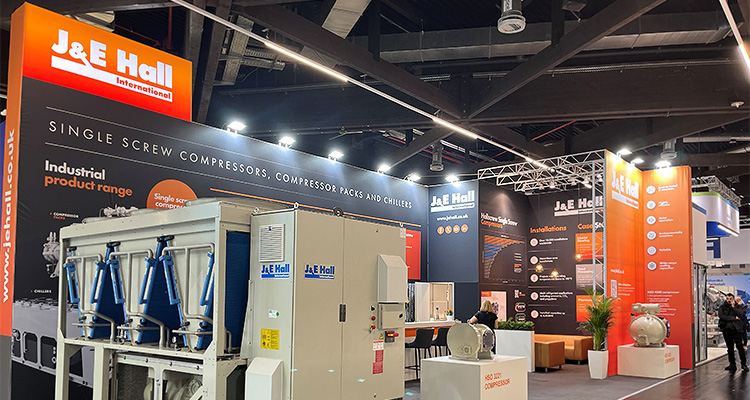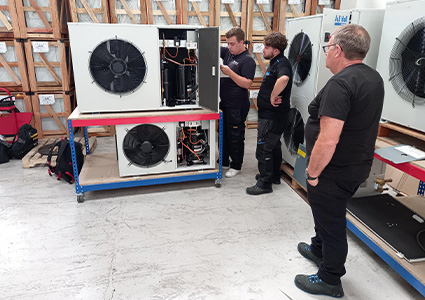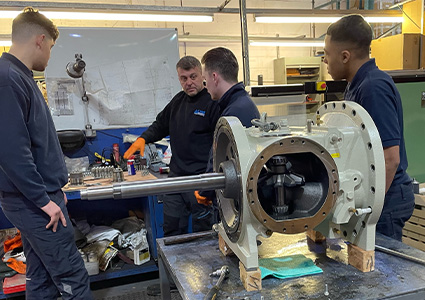
How J&E Hall collaborates with clients to meet their evolving energy and regulatory needs
J&E Hall International (J&E Hall) is one of the world’s oldest industrial refrigeration companies. Managing Director, Andrew Bowden, elaborates: “Our history dates to 1785 when Mr. John Hall founded his one-man workshop in Dartford, Kent, in the UK. We’re so ingrained in the local area that there are streets named after employees as well as Mr. Hall’s portrait on bus stops. We’re an international industrial refrigeration business. We’ve used virtually every known refrigerant out there in most known applications, including nuclear. We are currently finishing a four-year project for the Hinckley Nuclear Power Station, and we have also recently won a project for the Sizewell C Nuclear Power Station. We’re known for being able to complete complex projects that other companies might struggle with. We’ve got different business units ranging from industrial and commercial products to service and maintenance, as well as a research and development facility through which we develop our future technologies.”
 Andrew then goes on to explain the significant steps the company has taken in the last five years: “Changing customer requirements and evolving regulations have been key drivers of innovation over the last five years. This has involved collaborating with our customers to create solutions that reduce energy, improve efficiency, as well as meet the F-gas (fluorinated gas) and PFAS (perfluoroalkyl and polyfluoroalkyl substances) regulations. We’re very pleased that these products will begin to be released this year.
Andrew then goes on to explain the significant steps the company has taken in the last five years: “Changing customer requirements and evolving regulations have been key drivers of innovation over the last five years. This has involved collaborating with our customers to create solutions that reduce energy, improve efficiency, as well as meet the F-gas (fluorinated gas) and PFAS (perfluoroalkyl and polyfluoroalkyl substances) regulations. We’re very pleased that these products will begin to be released this year.
“The biggest threat to our industry is a lack of skilled people. There is a national shortage of engineers across all profiles, but particularly for refrigeration. Therefore, recruitment represents one of our priorities; so much so that we developed our own training center, which the local mayor opened for us last year. The facility allows us to not only train our own engineers and our own apprentices but also our customers and our distributors as well. We now have several training centers, the main one being by our headquarters in Dartford; we also have a commercial training center in Derby and our vision is to convert one of our testing facilities in Scotland into a training center.
“This enables us to extend our recruitment process. Rather than limiting ourselves to the already qualified workforce in the market, what we’re able to do now, is actually engage with people who may not currently have the right skill sets that we need today but have the appetite and aptitude to develop. Because we can offer complete training packages, including necessary qualifications, people are motivated to join us.
“We’re also engaging with local schools and colleges. I’m personally a STEM ambassador and an enterprise advisor for local schools, for example. I help local schools set curriculum and policies that encourage students to enter into engineering and refrigeration, creating clear pathways. Instead of sitting here and complaining about the shortage, we are proactive, actively engaging with talent, globally to make it easy for people to join us and have a successful career with J&E Hall.”
Customer collaboration
Andrew then explains the company’s approach to the implementation of new technologies: “Our first technological priority is developing our own engineers. Control systems are constantly evolving and becoming more thorough in terms of the information they provide, how well they understand the equipment, and how they integrate into a client’s system. We’ve invested heavily in developing sophisticated tools such as our programmable logic control systems. Within our training centers, we have also developed a system from which engineers can learn methods such as fault finding and diagnosis.
“Our new products will include the facility of a cloud-based system, which allows customers to perform data capture and analysis. This will enable us to help our customers optimize their equipment and plant integration. It also enables us to support clients with maintenance and service prediction. Being able to better predict service requirements means we are able to draw up servicing contracts that meet their specific needs and have the least impact on operations.” 
Reiterating the importance of close collaboration with customers, Andrew continues, explaining how it can be a key driver of innovation: “Primarily, having a close relationship with our customers means being able to better support them. This also means being able to support their future needs. We are specialists in our field, just as our customers are specialists in their processes. We engage with our customers to understand what their processes and requirements are for the future; energy is often a priority, for example.
“The two main environmental pieces of legislation that have come in, F-gas and PFAS, also have a big effect on our customers. Now, they are looking at future-proofing refrigerants, as some specific refrigerants could be phased out in the near future. If we understand our customers’ evolving needs, then we’ll be better able to meet them in time to minimize any disruption.
“With our research and development facility and our training centers, we can bring customers in, do talks, and show them our current products. It also gives us a chance to ask the more complex questions pertaining to how we can best integrate our products into their processes. What form and function do they need us to design in order to integrate it into their facility?”
Andrew then looks to the future, outlining the company’s ambitions for the years to come: “As an international refrigeration company, one of our key markets for our products is India. As the investment into India’s infrastructure progresses, we’re in a key position to provide support. Food wastage, for example, is an area that has been identified as requiring action. This will require more cooling facilities and transport infrastructure. J&E Hall, as well as the Daikin Group, are well positioned to facilitate this. From warehouse and storage through to processing and transportation, together we can target each of these elements of the cold chain and help to transform the market.”